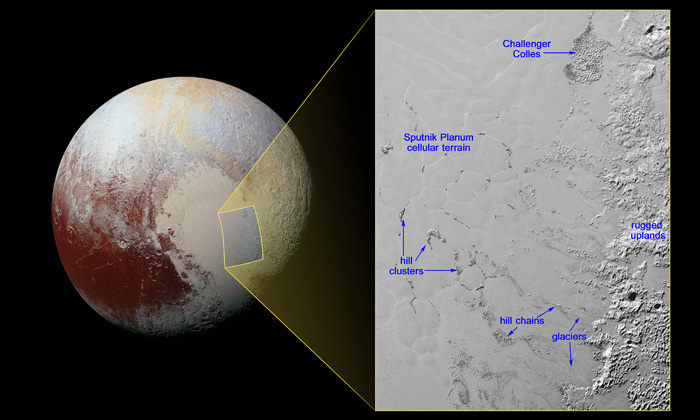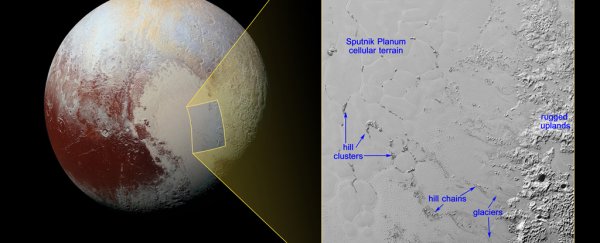A new image released by NASA reveals what appear to be slowly moving 'hills' of water ice on Pluto's surface, floating in a sea of frozen nitrogen.
According to astronomers from the New Horizon mission, these numerous, isolated fragments could be water ice from surrounding uplands. Located on the vast ice plain dubbed Sputnik Planum, which lies within the planet's famous heart-shaped territory, NASA's data indicates that the large objects measure up to several kilometres in width.
Scientists think that the hills are probably smaller versions of the larger mountains that occupy much of the western border of Sputnik Planum, and the unusual variation suggests we still stand to learn a lot about Pluto's mysterious geology and atmosphere.
While NASA's astronomers aren't entirely sure, they believe these water ice hills are effectively floating through the sea of frozen nitrogen, since water ice is less dense than nitrogen-dominated ice. If so, it's likely that the hill fragments would be moving slowly over time, much like icebergs on Earth, having broken away from the rugged uplands.
In the image below, you can see chains of the drifting hills that have formed along the flow paths of the nitrogen glaciers. If the astronomers are correct, the hills become subject to the convective motions of the nitrogen ice, and are eventually pushed into cluster formations (seen on the left side of the annotated image) that grow to be as wide as 20 kilometres (12 miles) across.
 NASA/JHUAPL/SwRI
NASA/JHUAPL/SwRI
The so-called Challenger Colles formation, informally named to honour the late crew of the Challenger space shuttle, looks to be a particularly large conglomeration of these hill structures, measuring some 60 by 35 kilometres (37 by 22 miles). NASA suggests the hills may have become beached here in great numbers, due to the nitrogen ice in this region of Sputnik Planum being especially shallow.
In its entirety, the new image, recorded by New Horizons' Multispectral Visible Imaging Camera (MVIC), shows an expanse of land about 500 by 340 kilometres (310 by 210 miles) in size, with the original resolution squeezing in about 320 metres (1,050 feet) per pixel.
New Horizons snapped the shot about 12 minutes before the spacecraft's closest approach to Pluto on 14 July 2015, at a distance of approximately 16,000 kilometres (9,950 miles) above the planet.
Pretty amazing stuff. And if NASA is successful in trialling its next-generation data transmission technology, next time we might not have to wait so long to find out this kind of data!
Sadly, the far-flung New Horizons, with its PlayStation 2-era brain, won't be getting an upgrade any time soon (being on the other side of the Solar System and all).
